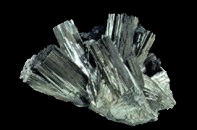|
|
| Formula: | MnO(OH) |  Click to see a larger image |
||
| Crystal: | Monoclinic | |||
| Hardness: | 4 | |||
| Spec. Gr.: | 4.33 | |||
| Streak: | Dark reddish brown | |||
| Cleavage: | Perfect side, fair basal | |||
| Location: | Ilfeld, Harz Mountains, Germany |
| The manganese deposits at Ilfeld, Germany have produced many of the world's best manganite crystals, including what may be the largest fine specimen (23cm by 14cm) currently displayed in Moscow's Fersman Museum. Manganite is a basic oxide of Manganese, crystallizes in short to long vertically striated prismatic crystals, often terminated by a flat base, and grouped in bundles. This jet-black mineral has a dark reddish-brown streak, a perfect side cleavage, and a number four hardness. The Appenrode mine, and others near it, were discovered and first worked during the 19th century. Manganese veins were but a few centimeters thick with most terminating at a depth of only twelve cm. Too small to interest important mining companies, they were worked by two or three man groups, and were abandoned by 1923. |
|
Bibliography: Bancroft, Peter, Gem and Crystal Treasures, 1984, pg. 415-418. |
|
University of California, Santa Barbara—Department of Earth Science Copyright © 2005 Regents of the University of California Send your comments to the Web Page Editor |